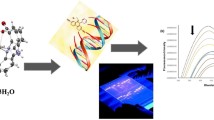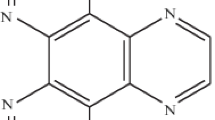Abstract
A new dinuclear copper(II) complex, [Cu(DPA)OH]2⋅2ClO4(Cu2-DPA2, DPA = di(pyridin-2-yl)amine), was synthesized and structurally characterized. The complex crystallized in a triclinic P-1 space group, taking on a slightly distorted tetragonal geometry. Both Cu(II) in Cu2-DPA2 are bridged by two hydroxyl groups with a distance of 2.938 Å. The whole molecule is nearly co-planar with the exception of the bridging hydroxyl groups. Complex Cu2-DPA2 can cleave efficiently supercoiled pBR322 DNA into its nicked and linearized forms at micromolar concentrations in the presence of ascorbate near physiological conditions. The presence of standard radical scavengers does not have any apparent effect on the cleavage efficiency, suggesting that Cu(II) bound oxygen intermediates rather than freely diffusible hydroxyl radicals may act as the active species in the DNA scission. Comparison of the cleavage reactivity of Cu2-DPA2 with that of mononuclear analogue Cu-DPA and trinuclear Cu3-L demonstrates that the synergistic effect between Cu(II) centers in Cu2-DPA2 is crucial for the DNA cleavage.
Similar content being viewed by others
References
Oivanen, M., Kuusela, S., Lonnberg, H.: Kinetics and mechanisms for the cleavage and isomerization of the phosphodiester bonds of RNA by Brønsted acids and bases. Chem. Rev. 98, 961–990 (1998). doi:10.1021/cr960425x
Pratviel, G., Bernadou, J., Meunier, B.: Carbon-hydrogen bonds of DNA sugar units as targets for chemical nucleases and drugs. Angew. Chem. Int. Ed. Engl. 34, 746–769 (1995). doi:10.1002/anie.199507461
Molenveld, P., Engbersen, J.F.J., Reinhoudt, D.N.: Dinuclear metallo-phosphodiesterase models: application of calix[4]arenes as molecular scaffolds. Chem. Soc. Rev. 29, 75–86 (2000). doi:10.1039/a804295k
Parkin, G.: Synthetic analogues relevant to the structure and function of zinc enzymes. Chem. Rev. 104, 699–767 (2004). doi:10.1021/cr0206263
Sigman, D.S.: In: Meunier, B. (ed.) DNA and RNA Cleavers and Chemotherapy of Cancer and Viral Diseases, p. 119. Kluwer, Dordrecht (1996)
Liu, C.-L., Wang, M., Zhang, T.-L., Sun, H.-Z.: DNA hydrolysis promoted by di- and multi-nuclear metal complexes. Coord. Chem. Rev. 248, 147–168 (2004). doi:10.1016/j.cct.2003.11.002
Pyle, A.M., Barton, J.K.: In: Lippard, S.J. (ed.) Progress in Inorganic Chemistry, vol. 38, p. 413. Wiley, New York (1990)
Klein, C.B., Frenkel, K., Costa, M.: The role of oxidative processes in metal carcinogenesis. Chem. Res. Toxicol. 4, 592–604 (1991). doi:10.1021/tx00024a001
Cowan, J.A.: Chemical nucleases. Curr. Opin. Chem. Biol. 5, 634–642 (2001). doi:10.1016/S1367-5931(01)00259-9
Mancin, F., Scrimin, P., Tecilla, P., Tonellato, U.: Artificial metallonucleases. Chem. Commun. (Camb.), 2540–2548 (2005). doi:10.1039/b418164f
Thyagarajan, S., Murthy, N.N., Narducci Sarjeant, A.A., Karlin, K.D., Rokita, S.E.: Selective DNA strand scission with binuclear copper complexes: implications for an active Cu2–O2 species. J. Am. Chem. Soc. 128, 7003–7008 (2006). doi:10.1021/ja061014t
Gonzalez-Alvarez, M., Alzuet, G., Borras, J., Macias, B., Castineiras, A.: Oxidative cleavage of DNA by a new ferromagnetic linear trinuclear copper(II) complex in the presence of H2O2/sodium ascorbate. Inorg. Chem. 42, 2992–2998 (2003). doi:10.1021/ic020611n
Humphreys, K.J., Johnson, A.E., Karlin, K.D., Rokita, S.E.: Oxidative strand scission of nucleic acids by a multinuclear copper(II) complex. J. Biol. Inorg. Chem. 7, 835–842 (2002). doi:10.1007/s00775-002-0369-8
Pogozelski, W.K., Tullius, T.D.: Oxidative strand scission of nucleic acids: routes initiated by hydrogen abstraction from the sugar moiety. Chem. Rev. 98, 1089–1108 (1998). doi:10.1021/cr960437i
Burrows, C.J., Muller, J.G.: Oxidative nucleobase modifications leading to strand scission. Chem. Rev. 98, 1109–1152 (1998). doi:10.1021/cr960421s
An, Y., Tong, M.-L., Ji, L.-N., Mao, Z.-W.: Double-strand DNA cleavage by copper complexes of 2,2′-dipyridyl with electropositive pendants. Dalton Trans. 2066–2071 (2006). doi:10.1039/b516132k
Zhao, Y.M., Zhu, J.H., He, W.J., Yang, Z., Zhu, Y.G., Li, Y.Z., Zhang, J.F., Guo, Z.J.: Oxidative DNA cleavage promoted by multinuclear copper complexes: Activity dependence on the complex structure. Chem. Eur. J. 12, 6621–6629 (2006). doi:10.1002/chem.200600044
Selmeczi, K., Giorgi, M., Speier, G., Farkas, E., Réglier, M.: Mono-versus binuclear copper(II) complexes in phosphodiester hydrolysis. Eur. J. Inorg. Chem. 5, 1022–1031 (2006). doi:10.1002/ejic.200500595
Childs, L.J., Malina, J., Rolfsnes, B.E., Pascu, M., Prieto, M.L., Broome, M.L., Rodger, P.M., Sletten, E., Moreno, V., Rodger, A., Hannon, M.J.: A DNA-binding copper(I) metallosupramolecular cylinder that acts as an artificial nuclease. Chem. Eur. J. 12, 4919–4927 (2006). doi:10.1002/chem.200600060
Jin, Y., Lewis, M.A., Gokhale, N.H., Long, E.C., Cowan, J.A.: Influence of stereochemistry and redox potentials on the single- and double-strand DNA cleavage efficiency of Cu(II) center dot and Ni(II) center dot Lys-Gly-His-derived ATCUN metallopeptides. J. Am. Chem. Soc. 129, 8353–8361 (2007). doi:10.1021/ja0705083
da Silveira, V.C., Luz, J.S., Oliveira, C.C., Graziani, I., Ciriolo, M.R., da Costa Ferreira, A.M.: Double-strand DNA cleavage induced by oxindole-Schiff base copper(II) complexes with potential antitumor activity. J. Inorg. Biochem. 102, 1090–1103 (2008). doi:10.1016/j.jinorgbio.2007.12.033
Lu, Z.L., Liu, T., Neverov, A.A., Brown, R.S.: Rapid three-step cleavage of RNA and DNA model systems promoted by a dinuclear Cu(II) complex in methanol. Energetic origins of the catalytic efficacy. J. Am. Chem. Soc. 129, 11642–11652 (2007). doi:10.1021/ja073780l
García-Giménez, J.L., Alzuet, G., González-Álvarez, M., Castiñeiras, A., Liu-González, M., Borrás, J.: A dinuclear copper(II) complex with adeninate bridge ligands and prominent DNA cleavage activity. Structural and spectroscopic characterization and magnetic properties. Inorg. Chem. 46, 7178–7188 (2007). doi:10.1021/ic700751j
Maheswari, P.U., van der Ster, M., Smulders, S., Barends, S., van Wezel, G.P., Massera, C., Roy, S., den Dulk, H., Gamez, P., Reedijk, J.: Structure, cytotoxicity, and DNA-cleavage properties of the complex CuII(pbt)Br2. Inorg. Chem. 47, 3719–3727 (2008). doi:10.1021/ic702306f
Humphreys, K.J., Karlin, K.D., Rokita, S.E.: Efficient and specific strand scission of DNA by a dinuclear copper complex: Comparative reactivity of complexes with linked tris(2-pyridylmethyl)amine moieties. J. Am. Chem. Soc. 124, 6009–6019 (2002). doi:10.1021/ja020039z
Humphreys, K.J., Karlin, K.D., Rokita, S.E.: Targeted strand scission of DNA substrates by a tricopper(II) coordination complex. J. Am. Chem. Soc. 124, 8055–8066 (2002). doi:10.1021/ja012539i
Kirin, S.I., Happel, C.M., Hrubanova, S., Weyhermüller, T., Klein, C., Metzler-Nolte, N.: Synthesis, structure and comparison of the DNA cleavage ability of metal complexes M(II)L with the N-(2-ethoxyethanol)-bis(2-picolyl)amine ligand L (M = Co, Ni, Cu and Zn). Dalton Trans. 1201–1207 (2004). doi:10.1039/b313634e
Tu, C., Shao, Y., Gan, N., Xu, Q., Guo, Z.: Oxidative DNA strand scission induced by a trinuclear copper(II) complex. Inorg. Chem. 43, 4761–4766 (2004). doi:10.1021/ic049731g
Chen, J.W., Wang, X.Y., Shao, Y., Zhu, J.H., Zhu, Y.G., Li, Y.Z., Xu, Q., Guo, Z.J.: A trinuclear copper(II) complex of 2,4,6-tris(di-2-pyridylamine)-1,3,5-triazine shows prominent DNA cleavage activity. Inorg. Chem. 46, 3306–3312 (2007). doi:10.1021/ic0614162
Marmur, J.: A procedure for the isolation of deoxyribonucleic acids from microorganisms. J. Mol. Biol. 3, 208–218 (1961)
Reichmann, M.E., Rice, S.A., Thomas, C.A., Doty, P.: A further examination of the molecular weight and size of sesoxypentose nucleic acid. J. Am. Chem. Soc. 76, 3047–3053 (1954). doi:10.1021/ja01640a067
Yergey, J.A.: A general approach to calculating isotopic distributions for mass spectrometry. Int. J. Mass Spectrom. Ion Phys. 52, 337–349 (1983). doi:10.1016/0020-7381(83)85053-0
Sheldrick, G.M.: SHELXTL, v5 Reference Manual, Siemens Analytical X-Ray Systems. Madison, WI (1996)
Wilson, A.J.: International Table for X-Ray Crystallography, Vol. C. Kluwer, Dordrecht (1992). Tables 6.1.1.4 (p. 500) and 4.2.6.8 (p. 219), respectively
Bernadou, J., Prativiel, G., Bennis, F., Girardet, M., Meunier, B.: Potassium monopersulfate and a water-soluble manganese porphyrin complex, [Mn(TMPyP)](OAc)5, as an efficient reagent for the oxidative cleavage of DNA. Biochemistry 28, 7268–7275 (1989). doi:10.1021/bi00444a019
Wu, L.P., Keniry, M.E., Hathaway, B.J.: Copper(I) reoxygenation products: the structures of di-μ-hydroxy-bis(di-2-pyridylamine)bis(tetrafluoroborato) dicopper(II) and μ-aqua-di-μ-hydroxy-bis(di-2-pyridylamine)dicopper(II) dichloride dehydrate. Acta Crystallogr. C 48, 35–40 (1992). doi:10.1107/S0108270191008703
Youngme, S., Somjitsripunya, W., Chinnakali, K., Chantrapromma, S., Fun, H.K.: The crystal and molecular structures of di-μ-hydroxy-bis(di-2-pyridylamine)dinitratodicopper(II) and aqua-μ-formato-triformato-bis(di-2-pyridylamine)dicopper(II) monohydrate. Polyhedron 18, 857–862 (1999). doi:10.1016/S0277-5387(98)00370-2
Youngme, S., van Albada, G.A., Roubeau, O., Pakawatchai, C., Chaichit, N., Reedijk, J.: Synthesis, crystal structures and magnetism of planar and roof-shaped hydroxo-bridged dinuclear copper(II) compounds with di-2-pyridylamine as a ligand. Inorg. Chim. Acta 342, 48–58 (2003). doi:10.1016/S0020-1693(02)01069-1
Waring, M.J.: Complex formation between ethidium bromide and nucleic acids. J. Mol. Biol. 13, 269–282 (1965)
Baguley, B.C., Le Bret, M.: Quenching of DNA-ethidium fluorescence by amsacrine and other antitumor agents: a possible electron-transfer effect. Biochemistry 23, 937–943 (1984). doi:10.1021/bi00300a022
Selvakumar, B., Rajendiran, V., Uma Maheswari, P., Stoeckli-Evans, H., Palaniandavar, M.: Structures, spectra, and DNA-binding properties of mixed ligand copper(II) complexes of iminodiacetic acid: The novel role of diimine co-ligands on DNA conformation and hydrolytic and oxidative double strand DNA cleavage. J. Inorg. Biochem. 100, 316–330 (2006). doi:10.1016/j.jinorgbio.2005.11.018
Kumar, C.V., Barton, J.K., Turro, N.J.: Photophysics of ruthenium complexes bound to double helical DNA. J. Am. Chem. Soc. 107, 5518–5523 (1985). doi:10.1021/ja00305a032
Mazumder, A., Sutton, C.L., Sigman, D.S.: 1,10-Phenanthroline-linked Escherichia coli Trp repressor as a site-specific scission reagent. Metal ion requirement. Inorg. Chem. 32, 3516–3520 (1993). doi:10.1021/ic00068a022
Sigman, D.S., Bruice, T.W., Mazumder, A., Sutton, C.L.: Targeted chemical nucleases. Acc. Chem. Res. 26, 98–104 (1993). doi:10.1021/ar00027a004
Suzuki, M., Furutachi, H., Ohkawa, H.: Bimetallic dioxygen complexes derived from ‘end-off’ compartmental ligands. Coord. Chem. Rev. 200–202, 105–129 (2000). doi:10.1016/S0010-8545(00)00323-4
Morrow, J.R., Iranzo, O.: Synthetic metallonucleases for RNA cleavage. Curr. Opin. Chem. Biol. 8, 192–200 (2004). doi:10.1016/j.cbpa.2004.02.006
Zhu, Q., Lian, Y.-X., Thyagarajan, S., Rokita, S.E., Karlin, K.D., Blough, N.V.: Hydrogen peroxide and dioxygen activation by dinuclear copper complexes in aqueous solution: hydroxyl radical production initiated by internal electron transfer. J. Am. Chem. Soc. 130, 6304–6305 (2008). doi:10.1021/ja800080z
Pope, L.M., Reich, K.A., Graham, D.R., Sigman, D.S.: Products of DNA cleavage by the 1,10-phenanthroline-copper complex. Inhibitors of Escherichia coli DNA polymerase I. J. Biol. Chem. 257, 12121–12128 (1982)
Blackburn, N.J., Rhames, F.C., Ralle, M., Jaron, S.: Major changes in copper coordination accompany reduction of peptidylglycine monooxygenase: implications for electron transfer and the catalytic mechanism. J. Biol. Inorg. Chem. 5, 341–353 (2000). doi:10.1007/PL00010663
Zhu, Q., Lian, Y., Thyagarajan, S., Rokita, S.E., Karlin, K.D., Blough, N.V.: Hydrogen peroxide and dioxygen activation by dinuclear copper complexes in aqueous solution: hydroxyl radical production initiated by internal electron transfer. J. Am. Chem. Soc. 130, 6304–6305 (2008). doi:10.1021/ja800080z
Author information
Authors and Affiliations
Corresponding author
Electronic Supplementary Material
Rights and permissions
About this article
Cite this article
Shao, Y., Chen, J. A Hydroxyl-bridged Dinuclear Copper Complex Having Planar Structure Shows Efficient DNA Cleavage Activity in Aqueous Solution. J Solution Chem 38, 1357–1367 (2009). https://doi.org/10.1007/s10953-009-9457-5
Received:
Accepted:
Published:
Issue Date:
DOI: https://doi.org/10.1007/s10953-009-9457-5




